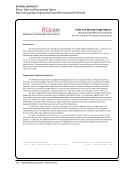170 · Representative Documents: Workflows
University of Michigan
BHL Web Archives: Methodology for the Acquisition of Content
http://bentley.umich.edu/dchome/webarchives/BHL_WebArchives_Methodology.pdf
August 2, 2011 9
Tags
WAS also allows archivists to “tag” archived websites with one or more subject
terms to facilitate user access to content. Archivists have therefore created tags that
identified significant groups of interrelated content: for example, the “College of
Engineering” tag identifies all archived websites that are created, maintained, or
associated with this particular college. When browsing the site list of a public
archives, a user may select a tag to review only those archived websites associated
with a specific subject (see Figure 7).
Figure 7
Tags are currently employed in both the Bentley Historical Library Web Archives
additional ones will be created as the collections continue to expand and as
archivists receive feedback from users. Management features in the curatorial
interface allow archivists to modify or delete tags all sites that are denoted by the
affected tags will inherit these changes (see Figure 8).
Figure 8
Many sites in the web archives do not have tags because they do not fit into these
established categories and tagging is only effective when there are a significant
number (i.e. five or more) of related sites. Archivists may, however, add tags to
existing archived websites should the need arise.
With the inclusion of description, metadata, and tags, the archivist may initiate the
web crawl and successfully conclude the workflow for content acquisition.
Archivists regularly meet to discuss the status of the web archives and review
difficult appraisal and content management decisions.
University of Michigan
BHL Web Archives: Methodology for the Acquisition of Content
http://bentley.umich.edu/dchome/webarchives/BHL_WebArchives_Methodology.pdf
August 2, 2011 9
Tags
WAS also allows archivists to “tag” archived websites with one or more subject
terms to facilitate user access to content. Archivists have therefore created tags that
identified significant groups of interrelated content: for example, the “College of
Engineering” tag identifies all archived websites that are created, maintained, or
associated with this particular college. When browsing the site list of a public
archives, a user may select a tag to review only those archived websites associated
with a specific subject (see Figure 7).
Figure 7
Tags are currently employed in both the Bentley Historical Library Web Archives
additional ones will be created as the collections continue to expand and as
archivists receive feedback from users. Management features in the curatorial
interface allow archivists to modify or delete tags all sites that are denoted by the
affected tags will inherit these changes (see Figure 8).
Figure 8
Many sites in the web archives do not have tags because they do not fit into these
established categories and tagging is only effective when there are a significant
number (i.e. five or more) of related sites. Archivists may, however, add tags to
existing archived websites should the need arise.
With the inclusion of description, metadata, and tags, the archivist may initiate the
web crawl and successfully conclude the workflow for content acquisition.
Archivists regularly meet to discuss the status of the web archives and review
difficult appraisal and content management decisions.










































































































































































































